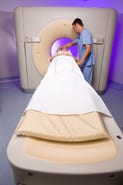Computed Tomography Scan
 Computed tomography (CT) scan is a sophisticated X-ray imaging system that scans thin "slices" of the body on all sides, then combines those slices into a highly detailed, three-dimensional digital image of hard and soft tissues in the body. The procedure is non-invasive, requires minimal radiation exposure, and can simultaneously depict tissues of different densities, which is not possible with traditional X-ray methods.
Computed tomography (CT) scan is a sophisticated X-ray imaging system that scans thin "slices" of the body on all sides, then combines those slices into a highly detailed, three-dimensional digital image of hard and soft tissues in the body. The procedure is non-invasive, requires minimal radiation exposure, and can simultaneously depict tissues of different densities, which is not possible with traditional X-ray methods.
Reasons for a CT Scan
CT scans are highly useful for examining injuries and abnormalities, guiding needle biopsies, and aiding in surgical preparation. A CT scan can detect:
- Bone, soft tissue or blood vessel abnormality
- Tumors, cancer
- Stroke, aneurysm, other cardiovascular diseases
- Infectious disease
- Functioning of stent implants
- Kidney and lung disorders
- Problems in the lower gastrointestinal tract
- Injuries to internal organs
CT scans are also commonly used to investigate joint and musculoskeletal disorders and diagnose or monitor spine problems, arthritis or osteoporosis.
Benefits of a CT Scan
The CT scan procedure is able to produce clear, detailed images of the bone, soft tissue, and blood vessels during just one exam. This procedure creates real-time images that can detect internal injuries or bleeding quickly and simply. The CT scan often eliminates the need for exploratory surgery or biopsy. There are no serious side effects associated with this procedure, making it a safe and effective procedure.
The CT Scan Procedure
The patient is positioned on a table and depending on the radiologist's instructions, may lie on his or her back, side, or stomach. The technician will leave the room and the table will move slowly through the CT scanner which is shaped like a large tube. The X-ray beam inside the CT unit spirals slowly around the patient on all sides, creating 360-degree images or slices of the area being examined. After the scan is complete, these slices are combined by computer into a highly detailed three-dimensional image of the site in question. Depending on the size of the area being scanned, the examination can take from 5 to 30 minutes to complete.
